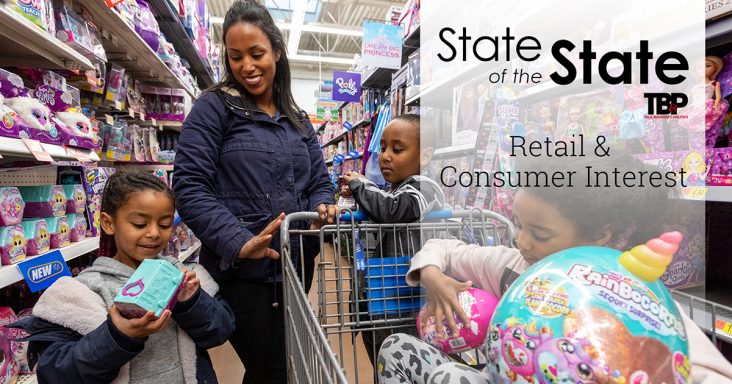State of the State 2023: Retail sector embraces economic uncertainty
by January 25, 2023 2:06 pm 995 views

Coming from record sales and a climate where consumers had extra money to spend, retailers are bracing for a year of transition amid a possible slowing economy, rising interest rates and dwindling savings, according to retail analysts and economists.
Brad Jashinsky, a director analyst at research firm Gartner, said retailers are reducing headcount and budgets to start 2023. He expects expansion plans, advertising and services will be scaled back as retailers reduce overhead. He said retailers are likely to take a “wait and see” approach as economic uncertainty continues through the first half of the year.
Retail analysts with Citigroup expect there will be winners and losers amid the retail sector again this year. They look for promotions and discounts to continue as retailers try to reduce inventory carried over from somewhat weaker holiday sales. Overall, retail profits will be harder to muster for brands of all sizes, the investment group noted in December.
Citigroup said Amazon is at an inflection point where its work with car manufacturers and insurance companies will start to pay off. The company is reducing its overhead costs by eliminating 6% of its corporate jobs, primarily in its retail and human resource units.
Walmart is also positioned to grow market share across multiple categories with its low-price strategy, according to Ben Bienvenue, a retail analyst with Stephens Inc. He said in the past three recessions, Walmart has outperformed the broader market.
Bed Bath & Beyond issued a warning for early 2023. The specialty home retailer is facing bankruptcy as it burns through its cash holdings. Macy’s also fired warning flares in early January, citing economic indicators from its proprietary credit card data. Macy anticipates a challenging sales environment, saying the consumer will continue to be pressured in the first half of 2023.
Retail analysts with Forrester believe mid-tier retailers like Macy’s and Kohl’s have the most to lose if consumers pull back spending. The consensus sentiment is that off-price and value-focused retailers such as TJ Maxx, Walmart or dollar stores tend to perform better during a slowing economy.
“Retailers that focus attention and ability on a handful of projects including strengthening infrastructure, improving margins and polishing the customer experience are likely to move the profit needle to the right,” said Susan Reda, strategy vice president at the National Retail Federation.
ONLINE VS IN-STORE
E-commerce sales growth slowed in 2022 as consumers flocked back to physical stores. Analysts with Forrester said retailers that can serve consumers online and in-store with little friction between the two shopping modes will reap the rewards. Forrester expects consumers will rely more on buy-online-pickup-in-store, which will require retailers to do a better job using stores as fulfillment centers.
Walmart and other retailers are piloting micro-fulfillment centers connected to stores to ensure online orders are picked and dispensed at faster speeds without interrupting the shopping experience for shoppers who take time to come into the stores.
NPD Group also touts the benefits of experiential retail this year for in-store shoppers saying there is a competitive advantage for retailers investing in experience. NPD found 59% of consumers expect retailers to dedicate more space to experiences. The study also found that 81% of shoppers are willing to spend more in retail stores that offer shopping experiences.
Livestream or social commerce shopping is also expected to take off this year. Coresignt Research estimates livestream e-commerce penetration to grow from $20 billion in 2022 to $57 billion in 2025. The research group reports 36% of U.S. consumers and 25% in the UK purchased something during a livestream in 2022.
CONSUMER CAUTION
Economists at Goldman Sachs said consumers began to transition to more cautious spending patterns in 2022, leading to negative discretionary cash flow for the first time since the 2008-2009 financial crisis. Goldman expects household cash flow should improve this year as inflationary pressures recede.
The New York Federal Reserve reported on Jan. 7 that the one-year outlook for household spending is down sharply from summer highs, thanks partly to higher credit card balances. The Fed Bank reported credit card balances rose 15% year-over-year in the third quarter, the biggest jump in 20 years. Lending Club reports 62% of consumers are living paycheck to paycheck as of November 2022.
As more consumers live with tighter budgets, the use of buy now, pay later (BNPL) options has never been greater from mainstream retailers like Walmart and online giants like Amazon. The BNPL services are viewed as problematic by Harvard economist Marshall Lux, who has been vocal on the topic, saying consumers already struggling with higher credit card debt don’t need to add to that pressure with BNPL purchases that draft the money directly from their checking accounts. He said these types of fintech programs, such as AfterPay, Klarna and Affirm, are unregulated and allow consumers to rack up debt regardless of their ability to repay.
Matt Schulz, the chief credit analyst at LendingTree, said consumers can be lax about jumping into these types of loans without fully thinking about spending future income. Juniper Research claims that 75% of BNPL users are either between the ages of 25 and 41. Also, 59% of users polled by Coresight Research said they used BNPL to purchase unnecessary items they couldn’t otherwise afford.
Editor’s note: The State of the State series provides reports twice a year on Arkansas’ key economic sectors. The series publishes stories to begin a year and stories in July/August to provide a broad mid-year update on the state’s economy. Link here for the State of the State page and previous stories.
